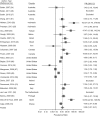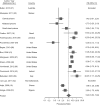HIV and Viral Hepatitis Among Imprisoned Key Populations
- PMID: 29688317
- PMCID: PMC5982732
- DOI: 10.1093/epirev/mxy003
HIV and Viral Hepatitis Among Imprisoned Key Populations
Abstract
Prisons and other closed facilities create opportunities for transmission of human immunodeficiency virus (HIV) and viral hepatitis during detention and after release. We conducted a systematic review and meta-analysis of peer-reviewed publications (2005-2015) to describe the prevalence of HIV, hepatitis C virus, and hepatitis B virus among key populations in prisons worldwide and to compare estimates of infection with those of other prison populations. Most data were reported for people who inject drugs (PWID; n = 72) and for men who have sex with men (MSM; n = 21); few data were reported on sex workers (SW; n = 6), or transgender women (n = 2). Publications were identified from 29 countries, predominantly middle- and high-income countries. Globally, PWID had 6 times the prevalence of HIV (pooled prevalence ratio (PPR) = 6.0, 95% CI: 3.8, 9.4), 8 times the prevalence of hepatitis C virus (PPR = 8.1, 95% CI: 6.4, 10.4), and 2 times the prevalence of hepatitis B virus (PPR = 2.0, 95% CI: 1.5, 2.7) compared with noninjecting prisoner populations. Among these articles, only those from Iran, Scotland, Spain, and Italy included the availability of methadone therapy; 2 articles included information on access to needle exchange programs by PWID detainees. HIV prevalence was more than 2 times higher among SW (PPR = 2.6, 95% CI: 2.2, 3.1) and 5 times higher among MSM (PPR = 5.3, 95% CI: 3.5, 7.9) compared with other prisoners. None of these articles reported HIV prevention coverage among SW or transgender women; 1 described HIV and sexually transmitted infection screening for MSM in prison. Prevention programs specific to key populations are important, particularly for populations that are criminalized and/or may cycle in and out of prison.
Figures







Similar articles
-
Epidemiology of HIV, Sexually Transmitted Infections, Viral Hepatitis, and Tuberculosis Among Incarcerated Transgender People: A Case of Limited Data.Epidemiol Rev. 2018 Jun 1;40(1):27-39. doi: 10.1093/epirev/mxx012. Epidemiol Rev. 2018. PMID: 29554240 Free PMC article.
-
Global burden of HIV, viral hepatitis, and tuberculosis in prisoners and detainees.Lancet. 2016 Sep 10;388(10049):1089-1102. doi: 10.1016/S0140-6736(16)30466-4. Epub 2016 Jul 14. Lancet. 2016. PMID: 27427453 Review.
-
Estimating prevalence and modelling correlates of HIV test positivity among female sex workers, men who have sex with men, people who inject drugs, transgender people and prison inmates in Sierra Leone, 2021.AIDS Res Ther. 2023 Sep 27;20(1):70. doi: 10.1186/s12981-023-00566-4. AIDS Res Ther. 2023. PMID: 37759241 Free PMC article.
-
Availability and Quality of Surveillance and Survey Data on HIV Prevalence Among Sex Workers, Men Who Have Sex With Men, People Who Inject Drugs, and Transgender Women in Low- and Middle-Income Countries: Review of Available Data (2001-2017).JMIR Public Health Surveill. 2020 Nov 17;6(4):e21688. doi: 10.2196/21688. JMIR Public Health Surveill. 2020. PMID: 33200996 Free PMC article. Review.
-
Prevalence of HIV, HCV and HBV in Central Asia and the Caucasus: A systematic review.Int J Infect Dis. 2021 Mar;104:510-525. doi: 10.1016/j.ijid.2020.12.068. Epub 2020 Dec 29. Int J Infect Dis. 2021. PMID: 33385583 Free PMC article.
Cited by
-
The Changing Science of HIV Epidemiology in the United States.Am J Epidemiol. 2019 Dec 31;188(12):2061-2068. doi: 10.1093/aje/kwz211. Am J Epidemiol. 2019. PMID: 31595945 Free PMC article. Review.
-
Understanding and Improving the Health of People Who Experience Incarceration: An Overview and Synthesis.Epidemiol Rev. 2018 Jun 1;40(1):4-11. doi: 10.1093/epirev/mxx018. Epidemiol Rev. 2018. PMID: 29860342 Free PMC article.
-
Characterizing the role of intersecting stigmas and sustained inequities in driving HIV syndemics across low-to-middle-income settings.Curr Opin HIV AIDS. 2020 Jul;15(4):243-249. doi: 10.1097/COH.0000000000000630. Curr Opin HIV AIDS. 2020. PMID: 32487815 Free PMC article. Review.
-
Service-Learning, Movies, and Infectious Diseases: Implementation of an Active Educational Program in Microbiology as a Tool for Engagement in Social Justice.Front Microbiol. 2021 Jun 29;12:589401. doi: 10.3389/fmicb.2021.589401. eCollection 2021. Front Microbiol. 2021. PMID: 34267731 Free PMC article.
-
The forgotten people: Hepatitis B virus (HBV) infection as a priority for the inclusion health agenda.Elife. 2023 Feb 9;12:e81070. doi: 10.7554/eLife.81070. Elife. 2023. PMID: 36757862 Free PMC article.
References
-
- Dolan K, Wirtz AL, Moazen B, et al. Global burden of HIV, viral hepatitis, and tuberculosis in prisoners and detainees. Lancet. 2016;388(10049):1089–1102. - PubMed
-
- Joint United Nations Programme on HIV/AIDS The Gap Report Geneva, Switzerland: Joint United Nations Programme on HIV/AIDS; 2014. http://www.unaids.org/en/resources/campaigns/2014/2014gapreport/gapreport. Accessed November 30, 2017.
-
- United Nations Office on Drugs and Crime, World Health Organization, Joint United Nations Programme on HIV/AIDS HIV and AIDS in Places of Detention: A Toolkit for Policymakers, Programme Managers, Prison Officers and Health Care Providers in Prison Settings New York, NY: United Nations Office on Drugs and Crime; 2008. http://www.who.int/hiv/pub/prisons/detention_toolkit/en/. Accessed November 30, 2017.
-
- Kutateladze BL, Andiloro NR, Johnson BD, et al. Cumulative disadvantage: examining racial and ethnic disparity in prosecution and sentencing. Criminology. 2014;52(3):514–551.
Publication types
MeSH terms
Grants and funding
LinkOut - more resources
Full Text Sources
Other Literature Sources
Medical

